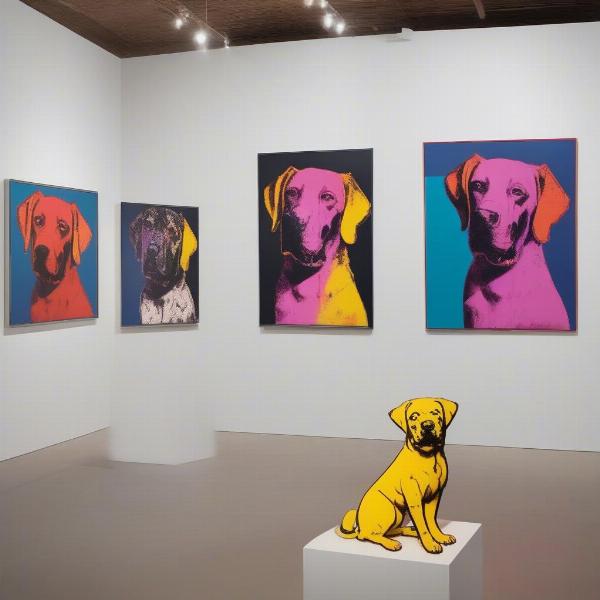Andy Warhol’s dog pop art is a fascinating intersection of fine art and canine adoration. While renowned for his Campbell’s Soup Cans and portraits of Marilyn Monroe, Warhol’s lesser-known depictions of dogs offer a unique glimpse into his artistic process and personal affections. This article will delve into the captivating world of Warhol’s dog-themed art, exploring its origins, significance, and enduring appeal for art lovers and dog enthusiasts alike.
Unveiling Warhol’s Canine Companions
Warhol’s love for dogs, particularly Dachshunds, was well-documented. He often included his own dogs, Archie and Amos, in his work, immortalizing them in vibrant silkscreens. These weren’t mere portraits; they were pop art statements, elevating everyday subjects to the realm of high art. This reflected Warhol’s broader artistic philosophy of blurring the lines between high and low culture. Beyond his own pets, Warhol also explored canine imagery more generally, creating works featuring other breeds and capturing the playful, loyal spirit of dogs.
Warhol’s fascination with dogs stemmed from more than just aesthetic appreciation. His dogs provided companionship and emotional support, acting as muses and confidants. This personal connection imbued his dog-themed works with a unique intimacy, making them more than just stylized depictions of animals. They are a testament to the bond between humans and their furry friends.
The Significance of Dogs in Pop Art
Dogs in pop art, particularly in Warhol’s work, represent a shift in artistic focus. Traditional art often prioritized grand historical narratives or idealized depictions of nature. Pop art, however, embraced the mundane, celebrating everyday objects and experiences. By featuring dogs, Warhol elevated a common subject, highlighting the importance of the everyday and the personal in art.
 Andy Warhol Dog Pop Art Exhibition
Andy Warhol Dog Pop Art Exhibition
Warhol’s dog art also contributed to the broader democratization of art. By focusing on familiar subjects like dogs, he made his art accessible to a wider audience, challenging the elitism often associated with the art world. His work resonated with people who might not have previously engaged with fine art, fostering a new appreciation for the artistic potential of everyday life.
Warhol’s Artistic Techniques and Dog Portraits
Warhol’s signature style, characterized by bold colors, repetitive imagery, and silkscreen printing, is evident in his dog portraits. He often used photographs as a starting point, then manipulated the images through cropping, colorization, and repetition. This process transformed his canine subjects into iconic pop art figures.
The bright, contrasting colors in Warhol’s dog art add to their playful and dynamic energy. They capture the vibrancy of life and the unique personality of each dog. The repetition of images further emphasizes the pop art aesthetic, highlighting the mass-produced nature of modern culture and blurring the lines between art and commercial imagery.
Conclusion: A Legacy of Paws and Pop
Andy Warhol’s dog pop art stands as a testament to his artistic genius and his genuine affection for his canine companions. By elevating the everyday subject of dogs to the realm of high art, Warhol challenged traditional artistic conventions and made art more accessible to a wider audience. His vibrant, stylized depictions of dogs continue to captivate and inspire, reminding us of the power of art to celebrate the simple joys of life, including the love and companionship of our furry friends.
FAQs:
- Did Andy Warhol own dogs? Yes, Warhol owned several Dachshunds, most notably Archie and Amos, who often featured in his artwork.
- Why did Warhol choose dogs as subjects for his art? Warhol’s love for his dogs, combined with his artistic philosophy of embracing everyday subjects, led him to incorporate them into his work.
- What is the significance of dogs in pop art? Dogs in pop art, like other mundane subjects, represent a shift away from traditional artistic themes and towards a celebration of everyday life.
- How did Warhol create his dog pop art? Warhol often used photographs as a basis for his dog portraits, then employed silkscreen printing and bold colors to achieve his signature pop art style.
- Where can I see Andy Warhol’s dog art? Warhol’s dog art can be found in various museums and private collections around the world.
sling to carry dog
sling for a dog
dog slings
About ILM Dog: ILM Dog is your trusted source for expert advice on all aspects of dog care, from breed selection and puppy care to senior dog health and training. We offer practical tips and insights to help you provide the best possible care for your canine companion. Whether you’re a seasoned dog owner or a first-time puppy parent, ILM Dog is here to support you every step of the way. Contact us at [email protected] or +44 20-3965-8624 for personalized guidance. Our expertise covers various areas including breed selection, health and wellness, training, nutrition, grooming, and finding the perfect products and accessories for your furry friend.